|
Information Systems Branch
The Information Systems Branch is headed by an Assistant Director. It handles all matters concerning development and operation of information systems, records management and personal data privacy of the Immigration Department.
To cope with the ever changing social and economic environment, the Department has been proactively formulating its information systems strategy to keep pace with the digital era of the 21st century and has been exploring the advanced technologies for delivering efficient and quality services to the public.
The Information Systems Branch comprises four functional divisions and is tasked to take charge of the information systems and related matters of the Department. The Information Systems (Development) Division is responsible for formulating and implementing the Department's information systems strategy, developing new systems to meet the future business needs. The Information Systems (Production) Division is responsible for management and security of information systems in operation as well as on-going enhancement of the systems and related processes. The Records and Data Management Division is responsible for all issues relating to data privacy, access to information and management of departmental records. The Technology Services Division provides technical support for the maintenance and development of computer systems in the Department. The former three divisions are each headed by a Principal Immigration Officer while the Technology Services Division is under the charge of a Chief Systems Manager.
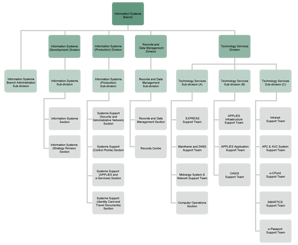 |
| Organisation Chart of the Information Systems Branch as at March 31, 2010. |
|
Following the roll-out of the Data Warehousing Information System (DWIS) on June 12, 2009, the Information Systems (Tactical Intelligence) Section was disbanded on July 2, 2009.
The Information Systems (Production) Division was reorganised on July 2, 2009. Four sections had been set up, namely Systems Support (Identity Card and Travel Documents) Section, Systems Support (APPLIES and e-Services) Section, Systems Support (Control Points) Section and Systems Support (Security and Administrative Network) Section to better meet the service needs of system users.
The Information Systems (Strategy Review) Section was established on January 4, 2010 to assist in planning and monitoring the review of the Department's Information Systems Strategy (ISS) undertaken by consultants.
Systems in Operation
Automated Passenger and Vehicle Clearance Systems (e-Channel)
The e-Channel is an automated system integrated with various technologies and unique business process to enable transformation of the traditional 'one-officer-one-counter/kiosk' clearance to self-service immigration clearance. By leveraging the smart identity card and biometric verification technologies, e-Channel was first rolled out at control points in December 2004 for use by Hong Kong permanent residents. After implementation of the e-Channels, savings have been realised for redeployment to other areas of more pressing needs. In January 2006, after the enactment of Immigration (Amendment) Ordinance 2005, e-Channel service was extended to Hong Kong residents holding Document of Identity for Visa Purposes and in September 2006 to those who have the right to land or are on unconditional stay as well as non-permanent residents who have been issued with a notification label. Eligible Hong Kong residents who are aged 11 or over holding smart identity card may perform self-service immigration clearance via the e-Channel.
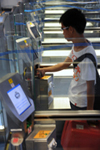 |
 |
| The e-Channel enables transformation of the traditional 'one-officer-one-counter/kiosk' clearance to self-service immigration clearance. |
|
In December 2007, the e-Channel service at the Lo Wu Control Point was extended to cross boundary primary school students under the age of 11.
In May 2008, the e-Channel service was extended to frequent visitors aged 18 or above holding HKSAR Travel Pass, Asia-Pacific Economic Co-operation Business Travel Card or Hong Kong International Airport Frequent Visitor Card. The service was further extended to eligible members of frequent flyer programmes of various airlines in September 2009.
To enhance the travel convenience between Hong Kong and Macao, from December 10, 2009 onwards, enrolled Macao permanent residents can use the e-Channels installed at the Macau Ferry Terminal and the China Ferry Terminal. At the same time, eligible Hong Kong residents can use the Macao Automated Passenger Clearance System (i.e. autogates) at control points in Macao.
 |
| From December 10, 2009 onwards, enrolled Macao permanent residents can use the e-Channels installed at the Macau Ferry Terminal and the China Ferry Terminal. |
|
In March 2009, the 'Express e-Channel' pilot scheme was introduced at the Lo Wu Control Point to provide faster e-Channel service to enrolled Hong Kong residents aged 18 or above who are existing e-Channel users. In view of the favourable feedback of the pilot scheme, the Department plans to install more 'Express e-Channels' at Lo Wu Control Point and will extend 'Express e-Channel' services to other control points.
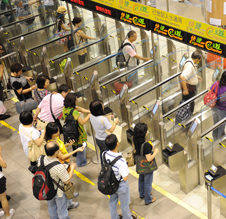 |
| 'Express e-Channel' at the Lo Wu Control Point. |
|
Entry / Exit Processing and Records System (EXPRESS)
The EXPRESS is an online information system, which provides efficient and reliable computer service to facilitate speedy clearance of passengers at control points. It also maintains travel records for enquiry purpose.
 |
| A channel supervisor at control point using personal digital assistant to handle referral case. |
|
Deployment Information and Command System (DICS)
Comprising closed circuit television function, immigration clearance statistics and counter assignment information, the DICS strengthens the operation at control points and facilitates the management to monitor the traffic situation real time for flexible deployment of staff.
Face Recognition System (FACES)
The FACES is effective in helping detect people who attempt to circumvent immigration control by using different identities. The system facilitates the work of officers at control points, investigation offices and visa-control offices to verify the identity of suspected passengers, immigration offenders and visa applicants.
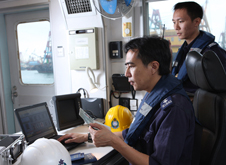 |
| An immigration officer using the Face Recognition System to verify the identity of a doubtful passenger. |
|
Smart Identity Card System (SMARTICS)
The SMARTICS is an on-line information system that supports the whole process of smart identity card production, from appointment booking, registration, production, to issue of smart identity cards. The system laid the foundation for the introduction of Automated Passenger Clearance System and Automated Vehicle Clearance System. Besides, the card also supports other non-immigration functions, such as library card and storage of e-Certificate, thus promoting e-Government and e-Commerce.
Electronic Passport (e-Passport) System
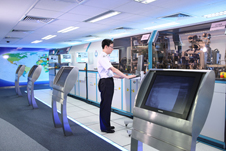 |
| Fully automated Travel Document Personalisation Centre. |
The e-Passport System supports one-stop passport application service, including appointment booking, application processing, and issuance of travel documents. By adopting the latest information technology, it achieves a paperless working environment and produces electronic passports with more advanced security features.
To further enhance customer service, eligible applicants of HKSAR passport aged 18 or above can submit passport application through the Internet or e-Passport self-service kiosks starting from end of 2007 and mid-2008 respectively. In addition, the online application service for e-Passport was further extended to eligible applicants aged 11 to 17 on November 30, 2009.
Application and Investigation Easy System (APPLIES) and Electronic Records Programme (ERP)
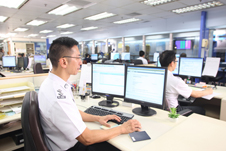 |
| Immigration staff using the Application and Investigation Easy System to process applications for visas and permits, etc. |
APPLIES is an on-line information system for processing applications for visas, permits, travel passes, registration matters relating to births, deaths, marriage and investigation cases. Following the full implementation of APPLIES in December 2008, electronic records can be stored and retrieved via computer workstations. Through the new electronic records and document management systems, there has been service improvement in processing applications and registration matters mentioned above. By adopting advanced technologies and designs, the system is able to handle and maintain operational and administrative records in an efficient and paperless manner. With the interface with the new Electronic Services System, the public can enjoy e-services, including booking of appointments and submission of applications through the Internet.
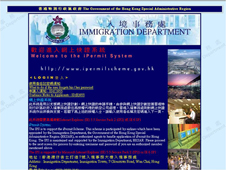 |
| The iPermit System |
iPermit System
The iPermit System was implemented on March 18, 2002 to support the issue of entry permits to visitors from Taiwan. Applications are submitted through authorised airlines in Taiwan and sent to Hong Kong electronically through the Internet. The result is made known to the applicant in just a few minutes. It significantly enhances the travel convenience of Taiwan residents.
Travel Pass Issuing System
The Travel Pass Issuing System supports the issue of Travel Pass to frequent visitors to Hong Kong. The information on the machine-readable Travel Pass is captured through optical character recognition readers and holders can enjoy speedy immigration clearance at the 'Hong Kong Residents' counters at control points.
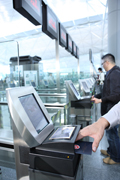 |
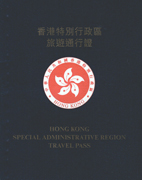 |
| Frequent visitors with HKSAR Travel Pass are able to enjoy self-service immigration clearance at the HKIA after enrolment with the Department. |
|
Asia-Pacific Economic Co-operation (APEC) Business Travel Card Issuing System
Hong Kong has participated in the APEC Business Travel Card Scheme since May 29, 1998. By making use of the Electronic Data Interchange System, the Scheme facilitates pre-cleared entry of accredited business people to the participating economies of the Asia-Pacific region.
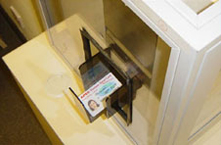 |
| Asia-Pacific Economic Co-operation (APEC) Business Travel Card Issuing System |
|
Government Office Automation (GOA) System
The GOA System enables speedy communication and dissemination of information through electronic means within the Department as well as among bureaux and departments of the HKSAR Government through the Government Communication Network.
Government-to-Employee (G2E) Applications
The e-Leave application is the first government-to-employee project. All staff members of the Department except the non-civil service contract staff can access the web-based application to process their leave applications as well as calculate and keep track of leave records through any networked computer workstation in the Department.
Operations and Administration Support Information System (OASIS)
The OASIS is an online information system which aims at enhancing productivity in operational and administrative areas. It facilitates management of information relating to personnel, stores and inventory. It also supports electronic compilation of duty roster and improves efficiency of staff deployment at control points.
Electronic Records (Administrative) System (e-Records(Adm))
The e-Records (Adm) System is an electronic records and document management system developed under the Electronic Records Programme. Leveraging advanced information technology and making use of GOA workstations and scanners, the system aims to improve efficiency in handling administrative records in the Department. Since April 2008, all staff of the Department can use the system to handle administrative records.
Intranet
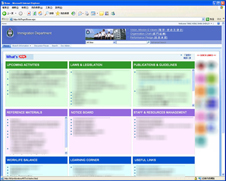 |
| The Intranet Portal Frontpage |
The Intranet provides an electronic channel for fast dissemination of multi-media information; enhances communications among staff; and acts as a platform for online computer-based training within the Department. From April 2009 to March 2010, the number of visits to the Intranet Portal exceeded two million, with a daily average of over 5 500 visits.
Immigration Department Homepage
To better serve the public, the Department has set up a homepage since May 31, 1996. Internet users can browse the latest information of the Department from the homepage and access websites of other related government departments/organisations. During the period from April 2009 to March 2010, the number of visits to the homepage was over five million with a daily average of 15 000.
Data Warehousing Information System (DWIS)
The last phase of DWIS was rolled out on June 12, 2009. The implementation of the DWIS will improve the provision of various statistical analyses as well as facilitate the management on decision making and resources planning.
Electronic Services
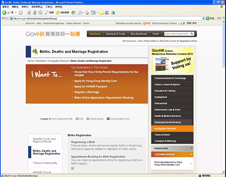 |
| Members of the public can use various immigration-related electronic services via the GovHK website. |
New Electronic Services have been implemented by phases at GovHK website since October 30, 2007. Up to March 31, 2010, members of the public can use the following electronic services via the GovHK website:
- apply for search and copy of births/deaths/marriage certificate;
- make appointment for registration of births;
- make appointment for giving of notice of intended marriage and submit information required for registration of marriage;
- make appointment for registration of Hong Kong smart identity card;
- apply for verification of eligibility for permanent identity card and submit supplementary documents;
- change or enquire about appointment for document verification relating to verification of eligibility for permanent identity card;
- enquire about the status of application relating to verification of eligibility for permanent identity card;
- apply for HKSAR Passport (for applicants aged 11 or above);
- make appointment for applying for HKSAR travel documents;
- make appointment for collection of HKSAR Passport or Document of Identity for Visa Purposes;
- make appointment for applying for extension of stay (except visitors and some application types);
- enquire about the status of application relating to Hong Kong visa;
- file notification of pre-mature termination of employment contract of foreign domestic helper;
- report immigration offences; and
- apply for access to information of Immigration Department.
Electronic Submission
Since 2000, the Department has been accepting electronic information sent by members of the public in specified format, manner and procedures requesting immigration services in accordance with the provisions of the Electronic Transactions Ordinance. Examples are provision of prescribed particulars of crew and passengers by an aircraft captain under the Immigration Ordinance and making a request for the Certificate of Registrar of Marriage for marriage to be solemnised in church under the Marriage Ordinance. Details can be found at the Department's homepage: www.immd.gov.hk.
Electronic Forms
Apart from accepting applications submitted by applicants in person or by post, the Department has devised electronic forms for the public to fill in and submit through the Internet for the following purposes:
- notification of change of particulars previously registered;
- notification of change of address;
- application for amendment of registered particulars of Hong Kong identity card; and
- application for access to information.
These electronic forms can be downloaded from the Department's homepage.
Information Systems Strategy Review
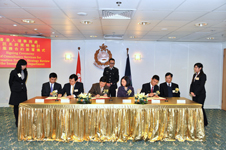 |
| On March 8, 2010, the Department commissioned consultants to study and formulate information systems strategy for the Department. |
The Immigration Department faces a constant pressure of minimising staff growth against an ever-increasing demand for its service in terms of both quality and quantity. To meet the challenge, the Department spares no effort to explore new technologies for improving productivity. On March 8, 2010, the Department commissioned consultants to conduct a comprehensive review of the Information Systems Strategy (ISS) which was formulated in 1999. The review aims at formulating a new ISS for the Department with a view to identifying service improvement opportunities and refreshing its information technology assets to better meet public needs. The review will take about six months to complete.
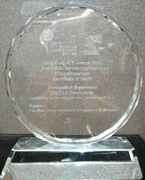 |
| The Certificate of Merit in the Best Public Service Application (Transformation) of the Hong Kong ICT Awards 2009. |
Achievements
The Hong Kong Information and Communications Technology (ICT) Awards 2009
The Application and Investigation Easy System (APPLIES) won the Certificate of Merit in the Best Public Service Application (Transformation) of the Hong Kong ICT Awards 2009.
|










